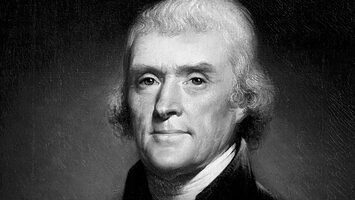American Founding
Encyclopedia
The American Revolution stands out as one of modern history’s few major political and philosophical movements that resulted in an increase in liberty. It asserted, through words and deeds, the equal rights of all individuals to governments dedicated to the protection of their lives, liberties, and pursuits of happiness. As Thomas Jefferson, one of the Revolution’s leading statesmen, wrote in 1826, the American independence movement advanced “the free right to the unbounded exercise of reason and freedom of opinion.” The era of the American Revolution embraces three overlapping phases. In the first phase (1763–1776), colonists in British North America rediscovered a rich ideological tradition that emphasized freedom from coercion. In the second phase (1775–1783), self-proclaimed citizens of the new United States waged a war for independence that asserted this principle, yet also tested it. The third and final phase (1781–1791) witnessed attempts to reconcile the principles for which the war had been fought with the lessons that it and ensuing events seemed to teach. The success of this long-term struggle owes much not only to the ideas from which it emerged, but also from the commitment of the individuals who thought, fought, and acted in its behalf.
In 1763, few American colonists contemplated independence. Most exulted in their connection with Britain, which they had recently helped in the defeat of French forces in North America. Britain stood preeminent as the nation possessing the most global power and, more important, enjoying the most freedom. Ever since the Glorious Revolution of 1688, Britons had claimed the collective right of self government. In addition, as John Locke famously asserted in his Two Treatises of Government (1690), Britons maintained that the only legitimate object of their laws was to protect the rights of each individual “to life, liberty, and estate.” The English Bill of Rights of 1689 guaranteed these rights and placed limits on the purposes and powers of government. France, meanwhile, with its powerful monarchy and hierarchical Roman Catholic Church, struck the British Americans of 1763 as freedom’s defeated oppressor.
The war with France set in motion a chain of events that undermined the optimism of American colonists and caused them to question the British government’s commitment to their rights. Britain’s debt doubled during the conflict, which drove the French from the North American continent, but merely humbled their American Indian allies. To help soothe tensions with Indians and reduce the costly need for the stationing of British troops along the frontiers of settlement, King George III issued the Proclamation of 1763, which prohibited the growing colonial population’s expansion west of the Appalachian Mountains. Even more disturbing to most colonists, in March 1765, Parliament passed the Stamp Act, which aimed to help compensate the British government for the cost of maintaining soldiers in the colonies. It required that colonists pay for official seals affixed to documents such as newspapers, legal contracts, diplomas, and customs records.
American colonists responded with anger tempered by principle. Previously, Parliament had claimed authority only over the colonies’ external trade and appealed to colonial assemblies for revenue. In levying the Stamp Act, however, Parliament for the first time taxed colonists directly and without the consent of their elected representatives. The colonists protested the law through public demonstrations, harassment of tax collectors, and a boycott of British goods. In 1765, a Stamp Act Congress was called to formally protest the tax, to which nine colonies sent delegates. Responding to these measures, Parliament repealed the Stamp Act a year after its passage. However, Parliament then enacted a Declaratory Act, asserting its legislative authority over the colonies “in all cases whatsoever.”
The Stamp Act crisis served to rehearse the patterns of protest that characterized the colonists’ responses to subsequent British legislation, including the 1767 Townshend Acts, which taxed imported products such as glass, lead, paint, and tea. In this instance, Parliament again reacted with partial capitulation. In 1770, it repealed all the duties except for the one on tea. The December 16, 1773, Boston Tea Party, however, provoked not retreat by Parliament, but a renewed commitment to punish colonists who engaged in extralegal activities. Although the men who had dumped 342 chests of taxed tea did so as anonymous private citizens, the Coercive Acts, passed in 1774, punished all the people of Massachusetts by closing Boston Harbor and provided that trials of British soldiers and officials accused of crimes in Massachusetts would be held in England, thus effectively shutting down local and colonial government. Parliament also passed a law that permitted British troops to be billeted in private homes throughout the colonies. The earlier assertions by radical colonists that the British government was conspiring to enslave colonists by taking away their rights to freely trade, negotiate voluntary contracts, govern themselves, and control their own property now seemed confirmed.
In response, colonies sent representatives to the First Continental Congress, which convened in Philadelphia in the fall of 1774. The Congress called on each colony to strengthen its military defenses and coordinate economic sanctions against Britain with the other colonies. It further recommended that Massachusetts form an independent government. After petitioning the king and Parliament to redress their grievances, the Congress resolved to reconstitute itself the following year if its complaints had not been addressed. When the Second Continental Congress gathered in May 1775, skirmishes between British troops and colonists at Lexington and Concord, Massachusetts, had already touched off what would become a War for Independence.
The Second Continental Congress quickly formed the Continental Army and designated George Washington as its commander. In July, it issued a final Olive Branch Petition to George III, which he rejected the following month. Diplomatic efforts seemed doomed as the war intensified. These facts, combined with the January 1776 publication of Thomas Paine’s influential pamphlet, Common Sense, spurred the Continental Congress to adopt the Declaration of Independence in July. The Declaration, written principally by Jefferson, reflected Americans’ broad agreement with the philosophies of Locke, George Mason, and other advocates of limited government and individual rights. It listed in detail Britain’s abuses of power and bolstered the legitimacy of the independence of the American states, the citizens of which had already begun to form autonomous governments under new constitutions.
The most fundamental innovation of these political charters was that they claimed sovereignty not for a monarch, but for the people. In addition, all of the state constitutions incorporated measures designed to deny excessive power to the new governments and the men who held office within them. During the imperial crisis of 1763–1776, royal governors had used their authority to silence the voices of colonial legislatures. Now, however, the new states’ chief executives commanded little independent power. Yet these constitutions generally checked even the power of popular legislatures by dividing them into an upper house, the members of which (depending on the state) were entrusted to 1- to 3-year terms, and an annually elected lower house. The few exceptions to this general pattern selected different means to achieve similar ends. Pennsylvania’s 1776 constitution, for example, provided for a unicameral assembly elected annually; laws required the approval of two successive assemblies in order to take effect. Other provisions also acted as checks on government power. The state constitutions opened the franchise to large numbers of citizens who owned enough property to render themselves economically independent. Others, according to their republican beliefs, might too easily yield to the influence of powerful neighbors or seek to use government to profit at others’ expense. All of the constitutions included declarations of rights, and all of the states maintained their independence. Even after the 13 states ratified the Articles of Confederation in 1781, the Congress to which they sent delegates had little power to compel them to act or contribute funds.
In practice, this framework proved somewhat problematic, especially in time of war. Quick action was sometimes needed, yet the structure of the national government hampered decision making. It also occasionally failed to facilitate the reconciliation of the various states’ short-term interests. Washington and other Continental Army leaders frequently complained of poor equipment and supplies, lack of pay for soldiers, and—after the initial enthusiasm of 1775–1776 waned—low enlistment levels. To pay the army, Congress printed money that possessed little real value. Despite a few victories, the war progressed slowly for Americans, who, after the Battle of Saratoga in New York, gratefully welcomed the assistance of their former French enemies. Their assistance proved crucial at Yorktown in 1781, when the French helped to defeat British troops in the final battle of the war. Two years later, Britain ratified the Treaty of Paris, which officially ended the conflict and recognized American independence.
Throughout the 1780s, additional factors caused some Americans to fear that initial impulses to limit the authority and power of government had gone too far. In 1782–1783 in Newburgh, New York, for example, officers whispered that the last vestiges of the army might revolt if Congress failed to satisfy officers’ demands for pensions. Only after Washington reminded his men of the need for subordination to proper civilian authority did thoughts of conspiracy recede. Then in Massachusetts, in 1786–1787, indebted farmers led by former Army Captain Daniel Shays revolted after their state’s government refused to alter contracts with their creditors.
Spurred by these and other threats to civic order, the states sent delegates to Philadelphia in 1787 to set up a new national government. Both James Madison and Alexander Hamilton, among others, persuaded other members of the Constitutional Convention to adopt a new constitution that created a national government with taxing powers and a strong executive. Most delegates expected Washington, possessed of a selflessness required of republican officeholders, to assume the role of chief executive. For some, however, not even Washington’s reassuring presence was enough. In 1791, the First Congress proposed 10 amendments, the Bill of Rights, to the Constitution, which were duly ratified. These amendments in some respect reflected the English Bill of Rights and aimed to guarantee the liberties for which the War for Independence had been fought.
Further Readings
Bailyn, Bernard. The Ideological Origins of the American Revolution. Cambridge, MA: Harvard University Press, 1967.
Colbourn, Trevor. The Lamp of Experience: Whig History and the Intellectual Origins of the American Revolution. Chapel Hill: University of North Carolina Press, 1965.
Higginbotham, Don. The War of American Independence: Military Attitudes, Policies, and Practice, 1763–1789. New York: Macmillan, 1971.
Maier, Pauline. From Resistance to Revolution: Colonial Radicals and the Development of American Opposition to Britain, 1765–1776. New York: Alfred A. Knopf, 1972.
Rakove, Jack N. Original Meanings: Politics and Ideas in the Making of the Constitution. New York: Alfred A. Knopf, 1996.
Royster, Charles. A Revolutionary People at War: The Continental Army and American Character, 1775–1783. Chapel Hill: University of North Carolina Press, 1979.
Wood, Gordon S. The Creation of the American Republic, 1776–1787. Chapel Hill: University of North Carolina Press, 1969.























